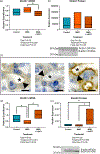Nanoparticle-mediated transgene expression of insulin-like growth factor 1 in the growth restricted guinea pig placenta increases placenta nutrient transporter expression and fetal glucose concentrations
- PMID: 36094907
- PMCID: PMC10947605
- DOI: 10.1002/mrd.23644
Nanoparticle-mediated transgene expression of insulin-like growth factor 1 in the growth restricted guinea pig placenta increases placenta nutrient transporter expression and fetal glucose concentrations
Abstract
Fetal growth restriction (FGR) significantly contributes to neonatal and perinatal morbidity and mortality. Currently, there are no effective treatment options for FGR during pregnancy. We have developed a nanoparticle gene therapy targeting the placenta to increase expression of human insulin-like growth factor 1 (hIGF1) to correct fetal growth trajectories. Using the maternal nutrient restriction guinea pig model of FGR, an ultrasound-guided, intraplacental injection of nonviral, polymer-based hIGF1 nanoparticle containing plasmid with the hIGF1 gene and placenta-specific Cyp19a1 promotor was administered at mid-pregnancy. Sustained hIGF1 expression was confirmed in the placenta 5 days after treatment. Whilst increased hIGF1 did not change fetal weight, circulating fetal glucose concentration were 33%-67% higher. This was associated with increased expression of glucose and amino acid transporters in the placenta. Additionally, hIGF1 nanoparticle treatment increased the fetal capillary volume density in the placenta, and reduced interhaemal distance between maternal and fetal circulation. Overall, our findings, that trophoblast-specific increased expression of hIGF1 results in changes to glucose transporter expression and increases fetal glucose concentrations within a short time period, highlights the translational potential this treatment could have in correcting impaired placental nutrient transport in human pregnancies complicated by FGR.
Keywords: fetal growth restriction; insulin-like 1 growth factor; placenta; pregnancy; therapeutic.
© 2022 Wiley Periodicals LLC.
Conflict of interest statement
CONFLICTS OF INTEREST
The authors declare no conflicts of interest.
Figures






Similar articles
-
Maternal-fetal interfaces transcriptome changes associated with placental insufficiency and a novel gene therapy intervention.Physiol Genomics. 2025 Jan 1;57(1):8-15. doi: 10.1152/physiolgenomics.00131.2024. Epub 2024 Oct 7. Physiol Genomics. 2025. PMID: 39374081 Free PMC article.
-
Placenta hIGF1 nanoparticle treatment in guinea pigs mitigates FGR-associated fetal sex-dependent effects on liver metabolism-related signaling pathways.Am J Physiol Endocrinol Metab. 2025 Mar 1;328(3):E395-E409. doi: 10.1152/ajpendo.00440.2024. Epub 2025 Feb 5. Am J Physiol Endocrinol Metab. 2025. PMID: 39907801 Free PMC article.
-
Placental nanoparticle gene therapy normalizes gene expression changes in the fetal liver associated with fetal growth restriction in a fetal sex-specific manner.J Dev Orig Health Dis. 2023 Jun;14(3):325-332. doi: 10.1017/S2040174423000016. Epub 2023 Feb 16. J Dev Orig Health Dis. 2023. PMID: 36794386 Free PMC article.
-
Expression of placental glucose transporter proteins in pregnancies complicated by fetal growth disorders.Adv Protein Chem Struct Biol. 2021;123:95-131. doi: 10.1016/bs.apcsb.2019.12.003. Epub 2020 Jan 22. Adv Protein Chem Struct Biol. 2021. PMID: 33485490 Review.
-
Regulation of nutrient transport across the placenta.J Pregnancy. 2012;2012:179827. doi: 10.1155/2012/179827. Epub 2012 Dec 10. J Pregnancy. 2012. PMID: 23304511 Free PMC article. Review.
Cited by
-
Regulation of placental amino acid transport in health and disease.Acta Physiol (Oxf). 2024 Jul;240(7):e14157. doi: 10.1111/apha.14157. Epub 2024 May 6. Acta Physiol (Oxf). 2024. PMID: 38711335 Free PMC article. Review.
-
Placental treatment with insulin-like growth factor 1 via nanoparticle differentially impacts vascular remodeling factors in guinea pig sub-placenta/decidua.Front Physiol. 2023 Jan 4;13:1055234. doi: 10.3389/fphys.2022.1055234. eCollection 2022. Front Physiol. 2023. PMID: 36685211 Free PMC article.
-
Rational Design of Nanomedicine for Placental Disorders: Birthing a New Era in Women's Reproductive Health.Small. 2024 Oct;20(41):e2300852. doi: 10.1002/smll.202300852. Epub 2023 May 16. Small. 2024. PMID: 37191231 Review.
-
Placenta-targeted Treatment Strategies for Preeclampsia and Fetal Growth Restriction: An Opportunity and Major Challenge.Stem Cell Rev Rep. 2024 Aug;20(6):1501-1511. doi: 10.1007/s12015-024-10739-x. Epub 2024 May 30. Stem Cell Rev Rep. 2024. PMID: 38814409 Free PMC article. Review.
-
Nanoparticle-mediated delivery of placental gene therapy via uterine artery catheterization in a pregnant rhesus macaque.Placenta. 2025 Jun 13;166:103-108. doi: 10.1016/j.placenta.2024.09.013. Epub 2024 Sep 20. Placenta. 2025. PMID: 39362807 Free PMC article.
References
-
- Abd Ellah NH, Potter SJ, Taylor L, Ayres N, Elmahdy MM, Fetih GN, & Pauletti GM (2014). Safety and efficacy of amine-containing methacrylate polymers as nonviral gene delivery vectors. Journal of Pharmaceutical Technology & Drug Research, 3(2), 7243.
-
- Alinejad V, Hossein Somi M, Baradaran B, Akbarzadeh P, Atyabi F, Kazerooni H, Samadi Kafil H, Aghebati Maleki L, Siah Mansouri H, & Yousefi M (2016). Co-delivery of IL17RB siRNA and doxorubicin by chitosan-based nanoparticles for enhanced anticancer efficacy in breast cancer cells. Biomedicine & Pharmacotherapy, 83, 229–240. 10.1016/j.biopha.2016.06.037 - DOI - PubMed
Publication types
MeSH terms
Substances
Grants and funding
LinkOut - more resources
Full Text Sources
Miscellaneous

